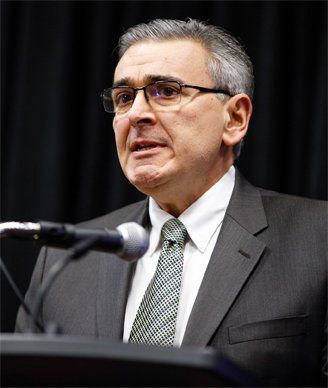CTCs Can Predict HR-Positive Breast Cancer Recurrence
A study found that circulating tumor cells are predictive of late recurrence in patients with hormone receptor–positive, HER2-negative early breast cancer.
Joseph A. Sparano, MD, presenting the results. Photo by © SABCS/Scott Morgan 2017

A study found that circulating tumor cells (CTCs) are predictive of late recurrence in patients with hormone receptor (HR)-positive, HER2-negative early breast cancer.
“Late recurrence in estrogen receptor–positive breast cancer is a huge clinical problem,” said Joseph A. Sparano, MD, of Montefiore Medical Center in New York. Late recurrences account for approximately half of all recurrences in estrogen receptor–positive disease; gene expression assays can predict for the risk of recurrence, but Sparano’s group hypothesized that detection of CTCs might function as a better biomarker for late recurrence.
Sparano presented results of an analysis testing this at the 2017 San Antonio Breast Cancer Symposium (SABCS), held December 5–9. They included 547 patients enrolled on a previous trial, and tested for CTCs using the CELLSEARCH assay. Most patients (56%) were over 50 years of age at diagnosis, 59% had a tumor size of at least 2 cm, and 73% had node-positive disease; 65% had HR-positive disease, and 88% had received endocrine therapy.
A total of 4.8% of patients were CTC-positive, defined as at least one cell in 7.5 ml of blood; 5.1% of HR-positive patients were CTC-positive, compared with 4.1% of HR-negative patients.
Over a median follow-up of 1.8 years, there were 14 recurrences (4%) in HR-positive patients, and only one recurrence (0.5%) in HR-negative patients. Among the 353 HR-positive patients, the hazard ratio for recurrence for those who were CTC-positive was 21.7 (95% CI, 7.0–67.8; P < .001). A multivariate model was similar, with a hazard ratio of 18.1 (95% CI, 5.0–65.3).
CTC-positive patients had a recurrence rate per person-year of 24.7%, compared with 1.5% for CTC-negative patients. The positive predictive value of the CTC test for 2-year recurrence was 35%, and the negative predictive value was 98%, meaning a negative test meant a 2% or less chance of recurrence with the next 2 years.
“This provides proof of concept of the clinical validity” of CTCs as a predictive marker, Sparano said during a press conference. He said it supports the concept of a “second decision point to tailor therapy to individual patients.” He also noted that the high level of risk stratification, at potentially more than 20-fold increased risk in CTC-positive patients, exceeds other biomarkers including the gene expression assays.
“We still have work to do,” Sparano added. “We need further study to really nail down what the clinical utility of this information is.” There remains a question of what clinicians can do with a positive CTC test, and whether a negative test can allow for scaled back treatment.
Kent Osborne, MD, of Baylor College of Medicine and a co-director of SABCS 2017, agreed. “I think it’s an intriguing result,” he said, “but we don’t know what to do with the data yet.”